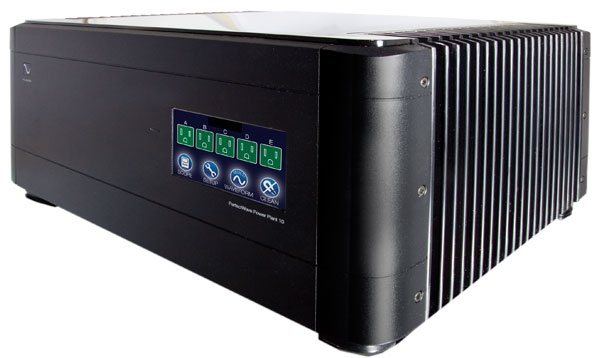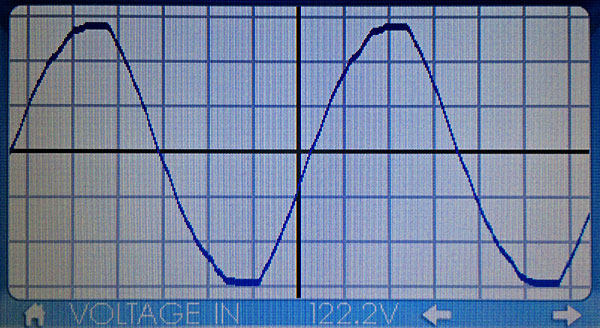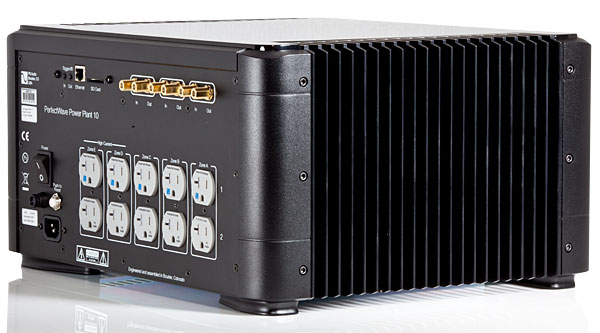| Columns Retired Columns & Blogs |
I assume that Fig 1 is the "before"? Can we get a screenshot of the "after"?

Surfing the sine
Power conditioners can be as simple as chokes: big chunks of magnetic stuff, usually ferrous metal, wrapped around your wire (or vice versa), and acting as inductors—and, hence, as low-pass filters, to remove high-frequency noise from the AC. Other, similarly passive power-treatment devices use fancier new materials and more sophisticated technologies, but PS Audio advises its customers not to put all their trust in AC power filters. They write, in the NuWave DSD's manual, that such devices may "'bleach' the sound and rob the music of life and dynamics." They should know: Their first power-treatment product, which went on sale 35 years ago, was an isolation transformer—itself a passive device.
Not everyone agrees that passive power conditioners degrade the sound, but the opinion can be defended on technical grounds: low-pass filters limit how fast current can flow—that's what low-pass filtering means in the time domain—which means that they also limit how fast power-supply capacitors can recharge. (Whether that limitation is enough to affect the sound is, of course, a different question.) Another problem with power filters is that they can't add back what's missing—eg, the top few volts shaved from the sinewave that comes in through my wall (fig.1): a consequence of the overwhelming demand from all the other consumers and businesses with which my home shares the power company's transformer (footnote 1). If the peaks of the incoming waveform are missing, the power-supply capacitors in my system may not get sufficient power when they need most to recharge.

PS Audio's solution is to start from scratch: take the power coming in through the wall, rectify it, store it, regulate it, use it to generate a new and better AC signal, and then send it out (with usefully low impedance). Think of it as a highly specialized source component that outputs just one frequency, combined with a powerful amplifier. As long as your devices don't crave more power than the Power Plant can deliver—1500VA (footnote 2) peak, 1200VA continuous—it should be a near-perfect solution to the problem of crappy power, assuming crappy power is a problem that needs solving.
And that's the key question: Is such a device actually necessary? The PerfectWave P10 Power Plant does what it says it does: It outputs a clean, high-power sinewave that's presumably of better quality than the one that comes from the power company. But for decades now, audio companies and designers have been dealing with tired, polluted sinewaves by incorporating into their products sophisticated, highly regulated power supplies. Indeed, the NuWave DSD DAC, which I was reviewing when PS Audio sent me the P10 Power Plant, boasts seven stages of regulation. Shouldn't that be enough?
It's true that the challenge for designers has increased over time. Especially in cities, circuits have become more crowded. With excess use and neglect, the electrical infrastructure has deteriorated—just like bridges and highways—and has not kept up with changes in technology. And now that wireless devices and cheap switching power supplies have become ubiquitous, there's a lot more high-frequency hash on our power lines than there used to be. But then, that stuff is so far above 60Hz that it should be possible to filter it out without doing audible harm. Do I really need to spend another $5000 to get the most out of my fancy high-end gear?
Auld lang sine
Two paragraphs ago, I wrote that the P10 outputs a sinewave. But that's not the only wave it puts out. The Power Plants—in addition to the P10, PS Audio sells the P5 ($3499, 1200VA) and the P3 ($2499, 750VA)—also output what the company calls MultiWave. PS Audio released their first regenerator, the P300, in 1997, and soon added a feature that made it possible for the user to adjust frequency, and to enjoy the performance differences that came about as a result: Is the bass more authoritative? Are the highs clearer? Is that smoke I smell?
Playing around with different waveforms, PS Audio's engineers heard differences, sometimes for the better, sometimes for the worse, usually with tradeoffs. Eventually, they settled on one approach: a modified waveform with a wider peak than a sinewave has. PSA says this waveform recharges power-supply capacitors more effectively than a standard sinewave, which makes sense: The waveform is at or near its highest for more of the cycle. In the P10 and P5 Power Plants, MultiWave is available in six strengths, with each progressive step correlating with increased capacitor-charging time (and thus decreased power-supply ripple); the P3 Power Plant offers just one MultiWave setting.
The P10 is extremely heavy—73 lbs—and it looks impressive in its black finish (silver is also available). It has 10 outlets in five separately regenerated zones—enough to support a complex audio and/or audiovisual system. Two pairs of outlets are labeled High Current; these are the same as the others, except that, when first turned on, they limit the inrush of power to power-hungry components, which is gentler on your devices and on your house or apartment's circuit breakers. In addition to MultiWave, there's a CleanWave output setting that you can use to degauss the transformers in your audio system.

An RJ45 socket on the rear panel allows Ethernet connectivity to a home network and, ultimately, the Internet. This doesn't enhance the P10's sonic performance, but does offer a number of control and convenience options: you can gather power-consumption and performance-tracking records, remotely schedule the P10 to turn on and to warm up before you get home from work, and assign names to individual zones and outlets. If you'd rather not bother with all that, you can make adjustments—and monitor your incoming and outgoing waveforms, complete with a 'scope-trace graphic and distortion stats—via the color touchscreen on the front panel.
Footnote 2: Volt-amps and watts are usually about the same, but occasionally, current and voltage get out of phase. When that happens, the actual power delivered to a device—the actual wattage—may be somewhat less than the product of volts times amps.

I assume that Fig 1 is the "before"? Can we get a screenshot of the "after"?

I've been living with the P10 for 4 months now. I consider it indispensable. I hear all the attributes you mention, but the most noticeable thing for me was the dynamic impact. And I have 'good' power - the P10 says my wall supply has 2.2% THD.
As a point of comparison, I would offer that I have never heard a set of interconnects or speaker cables that make the same magnitude of impact (and I'm a cable 'believer').

"the opinion can be defended on technical grounds: low-pass filters limit how fast current can flow"
Jim,
This is only true of *inductive* passive filtering. But not so with capacitive filtering, which is achieved with a parallel, not series connection and does not limit current flow, or the rise time for it.
Additionally, this does not have the ringing problem of the unfortunately ubiquitous conventional inductive technique. Also, there are inexpensive additional tricks for stripping RF garbage from the line. There are capacitance based power conditioners on the market. The regenerator types should more properly be compared to those if you want to talk about the effects on dynamics. Nor do they cost any voltage "off the top". Sorry, but on technical grounds, this review is incomplete.
(Good) regenerators do work well, but this is a very costly solution, where well designed passive types not using inductors can deliver excellent results at a fraction of the price. Plus, these do not have the current supply limitations of these bulky space consuming one-frequency (adjustable of not*) amplifiers, which is what these are after all, on electronic steroids. And the power supply to any piece of equipment is critical even if one is lucky enough to be located in "quiet valley with a little stream running through it, and your house is served by its own private transformer", even with great acoustics.
* Also useful as speed controls for turntables using AC synchronous motors, not mentioned in this article.

Can Stereophile provide before/after measurements of source, preamp, and amplifier behavior? I know they don't tell the whole story, but it would be extremely interesting to see if there are any changes in measured performance due to power conditioning.

Bob Ludwig's Gateway Mastering Studio in Portland Maine powers the studio gear with pure sine inverters powered by large batteries (said to be each the size of domestic kitchen refrigerators), disconnected from the battery chargers when in use.